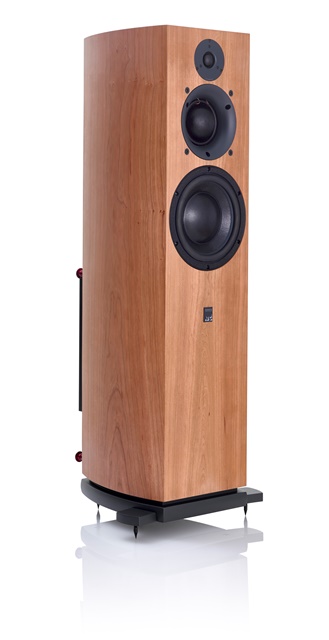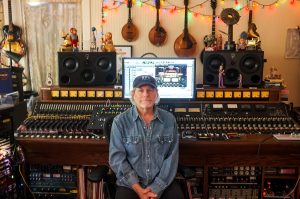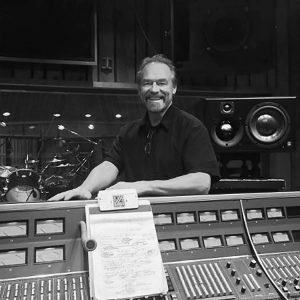Latest News
NASHVILLE ICON BUDDY MILLER SETTLES DOWN WITH ATC SCM45A MONITORS
NASHVILLE, TENNESSEE – AUGUST 2016: Buddy Miller is a Grammy Award-winning producer, songwriter, guitarist, and engineer. After getting his start in the late 1970s in New York City and Austin, he moved to Nashville and went on to produce dozens and dozens of big- and small-name talents, including Emmylou Harris, Patty Griffin, Shawn Colvin, and Robert Plant.
When he’s not on the road, Miller spends some of his days working out of his home studio with his wife, the talented singer-songwriter Julie Miller, who long complained that the studio monitors they used sounded unpleasant – until at last Miller found ATC monitors. The ATCs combine the accuracy and detail needed for mission-critical audio work with the joyful listening experience craved by lovers of great music. Building on three years’ success with ATC SCM25As, Miller recently upgraded to ATC SCM45As, which deliver greater bass response via two low-end drivers and greater high-end clarity with ATC’s made-in-house SH25-76S tweeter.
“Every link in the recording chain is important and it all adds up incrementally to the finished work,” Miller said. “But the monitors are the final link and the only window into what’s going on with all the other links. So I’ve long felt that the monitors have to be as good as they can possibly be. But at the same time, a lot of monitors are hard to listen to all day long. Julie is especially sensitive to the unpleasantness of most monitors. There were many times when we quit working because she just couldn’t take it any more.” Consequently, Miller spent over 25 years moving from one monitoring system to the next, trying to find something that was accurate enough to ensure consistent translation and yet truly pleasurable to listen to.
In the meantime, Miller built out the other components of his home studio, which is now centered on a vintage 28×24 Trident B-Range analog console, an MCI two-inch sixteen-track tape machine, Pro Tools HDX, tons of outboard gear (thirty-two channels of mic pres including a bunch of Telefunken V76 preamps, new and old Urei 1176s, a Fairchild 670, BAE1073s, DBX 160s, a Universal Audio LA-2A, a Manley Massive Passive, et al.) and a fantastic microphone collection. He even has a plate reverb system in his basement! His long, long search for accurate, but pleasant-sounding, monitors ended three years ago when he was working in another studio that had ATC near fields.
“When I heard the ATCs, I thought, ‘Whoa! This has everything!’,” he said. Miller purchased a pair of ATC SCM25A near field monitors, and he and Julie relished their inspiring (and yet still very detailed) sound. “The ATCs are so incredibly detailed in the midrange,” he said. “I can hear all of the reverb tails and delays – really everything that’s going on in a recording. The imaging is stunning. As a result, my recordings translate on any other system. They’re totally solid. And best of all, Julie loves to listen to them, so we get more work done and we get it done more enjoyably.”
These days, Miller likes to record with the entire band in the control room (sometimes even including the drums!) and with the singer in an adjoining room that has good line of sight to the control room. He’s had ample opportunity to perfect that technique: he served as Executive Music Producer for ABC’s drama Nashville for the past three seasons, which required producing and recording sixty to eighty songs per season, each with three recorded versions (a stripped-down songwriting version, a “live” version for the scene, and a polished studio version). In addition, Buddy hosts an ongoing weekly Sirius XM radio show that combines live recordings of artists with conversations.
Recently, Buddy upgraded their ATC SCM25As to ATC SCM45As. Both monitors are three-way designs, but the SCM45A adds as second 6.5-inch woofer for greater bass output. “I prefer not to work with subwoofers, but I wanted a little bit more bass from the monitoring system – not because it would affect my mixes so much, but because it would be more fun,” he said. “So when ATC released the SCM45A – which is essentially the monitor we had fallen in love with plus more bass – I jumped at the opportunity. They sound awesome, and they have so much output and low end that I got rid of my bigs. I have all the client-impressing-bigness I need from the SCM45As!” In addition, Miller is enchanted with the new ATC SH25-76S tweeters, which are now stock in the SCM45As. “The new tweeter is great!” he said. “The high end is beautiful and gives me even greater clarity and detail so I can get lost in the music.”
Transaudio Group – ATC US Distribution
Review: SCM40A – Stereotimes
The SCM40A continues to gain fans in the U.S. with Allen Edelstein of Stereotimes the latest critic to be taken in by the loudspeakers outstanding performance.
 Allen has reviewed the SCM40A for online magazine, Stereotimes and the review is live now. Here is a just a little insight into Allen’s thoughts on this compact ‘floorstander’ and why he thinks active design could be the way to go:
Allen has reviewed the SCM40A for online magazine, Stereotimes and the review is live now. Here is a just a little insight into Allen’s thoughts on this compact ‘floorstander’ and why he thinks active design could be the way to go:
“Adding everything together and how easily the ATC SCM40A can be used to produce a simple, elegant, high performance system this is a heck of a speaker system. And if you want a speaker system that allows great live recordings to make you think the performance is real, this is a must audition.”
Allen Edelstein, Stereotimes, August 2016.
You can read the review in full here at Stereotimes.
ATC MONITORS SURROUND FAMED RECORDING ENGINEER MICHAEL BISHOP
“Seasoned veteran” is perhaps too weak a term to describe audio engineer Michael Bishop, whose passion for breathtaking audio capture has earned him ten Grammy wins in a career that has spanned nearly 45 years. He served as the Chief Recording Engineer for Telarc Records from 1988 up until 2008, when Concord Music Group closed Telarc’s in-house production team, and now partners in Five/Four Productions, Ltd. with two of his former Telarc colleagues, Robert Friedrich and Thomas Moore. A tireless advocate of cutting-edge technologies, Bishop was experimenting with 24-bit, 192kHz recording when most engineers were still coming to terms with 16-bit, 44.1kHz and has since moved on to record/release in DTS, SACD, and now DSD. Since 1999, Bishop has relied on ATC monitors to reveal all of the minute details that cumulatively add up to a world-class recording. Three of his most recent projects include the recording of two new pieces by Jonathan Leshnoff performed by Robert Spano and the Atlanta Symphony Orchestra & Chorus, a traditional multi-track studio session with Eighth Blackbird, and the hip-hop/orchestral fusion of Pharrell William’s collaboration with the Dallas Symphony Orchestra.
Bishop traveled to Atlanta’s Woodruff Symphony Hall – a space where he has recorded nearly one hundred times – to create the world-premier recording of Jonathan Leshnoff’s Symphony No. 2 and Zohar. Although he’s never been one to create “documentary-style” recordings, Bishop is riding the leading edge of the wave that is moving traditional classical recordings in the direction of movie soundtracks. “There’s a lot more activity on the engineer’s part,” he said. “The audience is expecting more detail and color, and modern composers are writing pieces that really require the microphone technique needed to capture all of the details, actions, and interactions.”
Amazingly, Bishop mixed all 28 microphones on stage down to a stereo mix live in the moment that he recorded using DSD technology at 11.2MHz, or 256 times greater than the benchmark CD rate (44.1kHz x 256 = 11,200kHz!!!). As always, he brought his ATC SCM150ASL monitors. “The ATCs play a crucial role,” he said. “I’m making all of my recording, mixing, and mastering decisions right there, and it is thus paramount that I have an accurate image of every detail. Moreover, the 150s have the size and presence to give the producer and conductor a true impression of the recorded piece, which closes the feedback loop and gets us to a winning take with all due speed.” At a session cost of $300 per minute for the orchestra, that’s obviously important. Direct-to-stereo mixes have always been a hallmark of Bishop’s work over the past few decades so that it’s second nature.
“With ATCs, I’m able to make, say, a one-inch change in the angle of a microphone and really hear its effect,” Bishop said. “Most monitors gloss over that kind of detail, but those Eighth Blackbird are the details that add up to a great recording. Moreover, every ATC loudspeaker, from the 20s to the 300s, provides that same consistent level of detail.” Indeed, Bishop tracked on ATC SCM25A nearfield monitors at IV Lab Studios in Chicago, where he recently recorded the Chicago-based avant-garde ensemble Eighth Blackbird performing pieces written by five different contemporary composers for their Hand-Eye release on Cedille Records. “Eighth Blackbird was closer to a modern studio session, with the backbones of songs laid down, and followed by overdubs and manipulations of the recorded material as dictated by the composers.”
Bishop and longtime collaborator and former Telarc producer Elaine Martone were under pressure to work quickly. “The detail revealed by the ATCs greatly aided our decision making process and enabled us to make good decisions on the spot. With any recording session, there are a million things to worry about and manage,” he said. “ATC’s consistency and truth remove one of the most potentially damaging variables – we’re confident that what we’re hearing is the truth. That puts Elaine in a comfortable place and lets her focus on the musical aspects. She doesn’t have to question what she’s hearing.”
The Dallas Symphony Orchestra commissioned pop artist Pharrell Williams to compose a piece that he called “Rules of the Game” that also involves dance, sculpture, and video. Bishop crammed into the pit with a 28-piece chamber orchestra augmented by a hip-hop rhythm section, triggered samples, and an unusually heavy dose of percussion instruments. Of the session’s 72 tracks, 24 were devoted to percussion! Arranger and composer David Campbell, who has done similar work with Justin Timberlake, Beyoncé, and others, led the effort.
“Working in the pit is the pits,” Bishop laughed. “We were jammed in there, and I had to mic everything very closely. Everyone was on in-ear monitors so that they could stay in time with pre-recorded samples. It was pretty uncomfortable.” Back in the friendlier environs of the Five/Four studio, Bishop is mixing the performance on his 5.1 set of ATC SCM150ASLs. “The turnaround is tight because the dance company needs the recording for performances without a live orchestra,” he explained. “As always, the ATCs make it easy to mix and know that my work will translate to any system whatsoever. Since moving to ATC seventeen years ago, I’ve never been surprised by what a mix sounds like on a different system.”
Transaudio Group – ATC US Distribution








